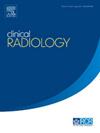Hepatic and pericardial fat in coronary computed tomography angiography and its association with coronary artery disease
IF 1.9
3区 医学
Q2 RADIOLOGY, NUCLEAR MEDICINE & MEDICAL IMAGING
引用次数: 0
Abstract
AIM
The aim of this study was to evaluate the association of both hepatosteatosis and epicardial adipose tissue (EAT) and paracardial adipose tissue (PAT) with coronary artery disease (CAD).
MATERIALS AND METHODS
The coronary computed tomography angiography (CCTA) images of 331 consecutive patients were retrospectively analysed. Epicardial and paracardial fat areas and hepatic attenuation values were measured on the same images. The presence and severity of coronary artery stenosis were assessed, and the coronary calcium burden was calculated.
RESULTS
No correlation was observed between the presence or severity of CAD and steatosis in either group. However, the proportion of patients with moderate and severe calcium scores was significantly higher in the steatosis group (P=0.016). EAT and PAT values were statistically significantly higher in the steatosis group than in the nonsteatosis group across both readers (P<0.05). Similarly, in patients with CAD, EAT and PAT values were statistically significantly higher than in those without CAD across both readers (P<0.05). The logistic regression analysis showed that PAT measurements significantly differed between individuals with and without CAD, with consistent results from both readers.
CONCLUSION
EAT and PAT values may be considered more useful than hepatosteatosis in assessing the risk of CAD. These parameters could serve as independent markers for determining the presence and severity of CAD.
冠状动脉ct血管造影中的肝脏和心包脂肪及其与冠状动脉疾病的关系
目的本研究的目的是评估肝骨化症、心外膜脂肪组织(EAT)和心旁脂肪组织(PAT)与冠状动脉疾病(CAD)的关系。材料与方法对连续331例患者的冠状动脉ct血管造影(CCTA)图像进行回顾性分析。在同一图像上测量心外膜和心旁脂肪区和肝脏衰减值。评估冠状动脉狭窄的存在和严重程度,并计算冠状动脉钙负荷。结果两组患者冠心病的存在及严重程度与脂肪变性无相关性。而脂肪变性组中钙评分为中重度的患者比例明显高于脂肪变性组(P=0.016)。两组读者中脂肪变性组的EAT和PAT值均显著高于非脂肪变性组(P<0.05)。同样,在有CAD的患者中,两种阅读器的EAT和PAT值均高于无CAD的患者(P<0.05)。逻辑回归分析显示,PAT测量值在患有和没有CAD的个体之间存在显著差异,两者的结果一致。结论在评估冠心病的风险时,eat和PAT值可能比肝纤维化更有用。这些参数可以作为判定CAD存在和严重程度的独立标志。
本文章由计算机程序翻译,如有差异,请以英文原文为准。
求助全文
约1分钟内获得全文
求助全文
来源期刊

Clinical radiology
医学-核医学
CiteScore
4.70
自引率
3.80%
发文量
528
审稿时长
76 days
期刊介绍:
Clinical Radiology is published by Elsevier on behalf of The Royal College of Radiologists. Clinical Radiology is an International Journal bringing you original research, editorials and review articles on all aspects of diagnostic imaging, including:
• Computed tomography
• Magnetic resonance imaging
• Ultrasonography
• Digital radiology
• Interventional radiology
• Radiography
• Nuclear medicine
Papers on radiological protection, quality assurance, audit in radiology and matters relating to radiological training and education are also included. In addition, each issue contains correspondence, book reviews and notices of forthcoming events.
 求助内容:
求助内容: 应助结果提醒方式:
应助结果提醒方式:


